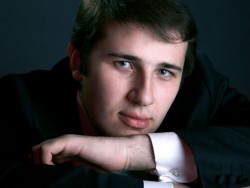by Daniel Hautzinger

Yet that’s exactly what Stanislav Khristenko did on July 26 in the intimate Bennett Gordon Hall at Ravinia, a music festival campus in Chicago’s northwestern suburbs that is akin to Cleveland’s Blossom Festival. First-prize winner of the 2013 Cleveland International Piano Competition, the Ukrainian-born Khristenko studied at the Cleveland Institute of Music and last year released a debut recording on the Steinway & Sons label of fantasies by Schumann, Bruckner, Brahms, and Zemlinsky.
As is apparent from that album’s combination of such touchstones as Schumann’s Fantasie with less familiar works by Bruckner and Zemlinsky, Khristenko is an intriguing programmer. His Ravinia recital, entitled “Music of the New World,” showcased famed American composers, exposing some surprising similarities between disparate styles.
Louis Moreau Gottschalk was America’s first pianistic star, becoming internationally popular in the mid-nineteenth century for his showy compositions that drew from American influences. Bamboula, danse des nègres and Le banjo, esquisse americaine, which opened Khristenko’s program, feature standard Romantic virtuoso techniques, such as the distribution of a melody between the hands with figuration on either side to give the aural illusion of three hands. Yet they are also inventive. Le banjo rollicks and lilts like its namesake through rapid alternations of notes and rolling momentum, while extensive use of the piano’s range in Bamboula conjures multiple instruments and natural sounds.
Khristenko is keenly attentive to such layers, coloring and voicing them to reveal the huge variety of suggested timbres. That chromatic nuance also illuminated Barber’s obsessive Piano Sonata. Some of the techniques in the Sonata seemed like updated versions of Gottschalk’s writing— for example, filling of the entire keyboard with multiple levels of music. But no technical challenge, not even the manic closing fugue, overcame Khristenko. He wrung intensity from the piece, its morose chords and themes expressive like an incandescent Rothko painting.
If Barber’s piece is a Rothko, Philip Glass’s Selections from “Metamorphosis” is the white gallery wall upon which it is hung: plain, and much more effective as a backdrop for images. (The first two movements, the only ones Khristenko performed, were originally for the soundtrack to the documentary The Thin Blue Line).
The cleverness of Khristenko’s programming resurfaced with George Gershwin’s Song-Book, Gershwin’s own brilliant arrangements of eighteen of his popular songs, including “Swanee,” “The Man I Love,” and “I Got Rhythm.” The jazzy syncopations and occasional dissonant jag in the accompaniment recalled the Barber, the flashy humor and extravagant flourishes the Gottschalk. But the short pieces are also highly original, the droll irony and lighthearted sentiment of the songs shining through Khristenko’s jocund performance and Gershwin’s idiomatic writing, despite the lack of lyrics.
With his shy demeanor, large frame, and penchant for thunderous sonorities, Khristenko is the last person you would think of pointing to for delightful performances of Gershwin. But the songs charmed and entertained marvelously at Ravinia. “’s Wonderful,” indeed.
Published on ClevelandClassical.com July 28, 2015.
Click here for a printable copy of this article



